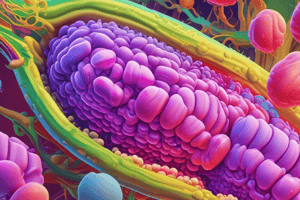Podcast
Questions and Answers
Which enzyme is primarily responsible for the digestion of triacylglycerols?
Which enzyme is primarily responsible for the digestion of triacylglycerols?
- Isomerase Enzyme
- Gastric Lipase
- Lingual Lipase
- Pancreatic Lipase (correct)
What percentage of 2-monoacylglycerols are directly absorbed without further conversion?
What percentage of 2-monoacylglycerols are directly absorbed without further conversion?
- 28%
- 22%
- 6%
- 72% (correct)
What is steatorrhea?
What is steatorrhea?
- A vitamin absorption disorder
- A digestive enzyme deficiency
- A condition of excessive fat in the stool (correct)
- A decrease in bile salts
Which type of adipose tissue is primarily composed of triacylglycerols and found under the skin?
Which type of adipose tissue is primarily composed of triacylglycerols and found under the skin?
What happens to 22% of 1-monoacylglycerols after they are converted from 2-monoacylglycerols?
What happens to 22% of 1-monoacylglycerols after they are converted from 2-monoacylglycerols?
What is the primary role of thermogenin in animals exposed to cold?
What is the primary role of thermogenin in animals exposed to cold?
Which enzyme is considered the key regulator of lipolysis?
Which enzyme is considered the key regulator of lipolysis?
Which factor is NOT typically considered a lipolytic factor?
Which factor is NOT typically considered a lipolytic factor?
What is the function of carnitine in fatty acid metabolism?
What is the function of carnitine in fatty acid metabolism?
In which site does β-oxidation of fatty acids primarily occur?
In which site does β-oxidation of fatty acids primarily occur?
Flashcards are hidden until you start studying
Study Notes
Digestion of Lipids
-
Triacylglycerols are digested by lipases:
- Lingual lipase secreted by Ebner’s glands on the tongue, has minimal effect due to short food retention in the mouth.
- Gastric lipase optimum pH is 5.5, active mainly in infant stomachs (pH: 5) acting on milk fat.
- Pancreatic lipase is the most important lipase, removing fatty acids at carbon 1 and 3, yielding a mixture of 2-monoacylglycerol and free fatty acids.
-
2-monoacylglycerols can be:
- Absorbed directly (72%).
- Converted to 1-monoacylglycerols by isomerase enzyme.
- 6% absorbed as 1-monoacylglycerol.
- 22% hydrolyzed by pancreatic lipase into glycerol and fatty acids, which are then absorbed.
-
Steatorrhea is a condition of increased fat content in stool.
- Causes: Deficiency of any factor essential for lipid digestion or absorption, including:
- Pancreatic lipase deficiency:
- Undigested fat in stool.
- No loss of fat-soluble vitamins.
- Bile salts deficiency:
- Digested fat present in stool.
- Loss of fat-soluble vitamins.
- Defective intestinal mucosa cells.
- Pancreatic lipase deficiency:
- Causes: Deficiency of any factor essential for lipid digestion or absorption, including:
Body Lipids
-
Tissue Lipids: Present in cell membranes and the brain, never oxidized for energy during starvation.
-
Depot Fat (Adipose Tissues):
- Sites: Under skin, breast, around kidney, in omentum & mesentry.
- Types:
- White adipose tissue: Composed mainly of triacylglycerols (TAG).
- Brown adipose tissue:
- Brown due to high blood supply and mitochondria content.
- Contains thermogenin (uncoupler protein), common in animals exposed to cold.
-
Functions of Depot Fat (Adipose Tissues):
- Energy source during starvation.
- Vitamin D3 synthesis (7-dehydrocholesterol under skin).
- Protection against cold.
- Protection of bony prominences.
- Kidney support.
Depot Fat vs. Tissue Fat
- Depot fat: Stored lipid.
- Tissue fat: Structural lipid.
- Depot fat type: Triacylglycerols (TG).
- Tissue fat type: Phospholipids.
- Depot fat amount: Variable.
- Tissue fat amount: Constant.
- Depot fat during starvation: Decreased.
- Tissue fat during starvation: Constant.
- Depot fat fatty acid: Saturated.
- Tissue fat fatty acid: Unsaturated.
- Depot fat site: Skin, around kidney.
- Tissue fat site: Cell wall, brain.
- Depot fat function: Energy source.
- Tissue fat function: Structural component.
Lipolysis
-
Carried out by three enzymes in adipose tissue:
- Hormone-sensitive triacylglycerol lipase (HS lipase).
- Diacylglycerol lipase.
- Monoacylglycerol lipase.
-
Causes of Lipolysis:
- Starvation.
- Diabetes Mellitus.
- Low carbohydrate diet.
- Certain infectious diseases (tuberculosis due to high catabolic state).
Regulation of Lipolysis
-
Key enzyme: Hormone-sensitive triacylglycerol lipase (HS lipase).
-
HS lipase exists in two forms:
- Active form: Contains phosphate.
- Inactive form: Lacks phosphate.
-
Lipolytic factors:
- Lipolytic hormones (anti-insulin):
- Epinephrine and norepinephrine.
- Glucagon.
- ACTH (adrenocorticotrophic hormone).
- TSH (thyroid stimulating hormone).
- Growth hormone.
- Methyl xanthine (caffeine).
- Sympathetic nervous system.
- Lipolytic hormones (anti-insulin):
-
Anti-lipolytic factors:
- Insulin.
- Nicotinic acid and prostaglandin E.
Oxidation of Fatty Acids
-
Β-oxidation: Occurs in mitochondria of liver, not brain.
-
Fatty acid transport into mitochondria:
- Fatty acyl CoA synthetase (thiokinase): Converts fatty acid to acyl CoA in the cytosol.
- Carnitine shuttle: Carnitine carries fatty acids from cytoplasm to mitochondria.
- Carnitine acyl transferase I: Transfers fatty acid from acyl CoA to carnitine, forming acyl carnitine.
- Carnitine Acylcarnitine translocase: Exchanges fatty acyl-carnitine for carnitine across the mitochondrial membrane.
- Carnitine acyl transferase II: Transfers fatty acid from carnitine to coenzyme A.
-
Energy production from β-oxidation:
- Palmitic acid (16 C): Net energy gain = 129 ATP.
- Calculation formula: (N/2 – 1) X 5 ATP) + (N/2 X 12 ATP) – 2 ATP (where N is the number of carbon atoms in the fatty acid).
-
Importance of β-oxidation:
- Energy production.
- Production of acetyl CoA.
- Ketone body formation.
Source and Fate of Acetyl CoA
-
Sources:
- Lipids: Oxidation of fatty acids and ketone bodies.
- Carbohydrates: Glucose oxidation → Pyruvate → Acetyl CoA.
- Proteins:
- Ketogenic amino acids: Directly give acetyl CoA or indirectly give acetoacetate → Acetyl CoA.
- Glucogenic amino acids: → Pyruvate → Acetyl CoA.
-
Fate:
- Oxidation: Through Krebs' (citric acid cycle).
- Lipogenesis: Formation of fatty acids and triacylglycerols.
- Ketogenesis: Synthesis of ketone bodies.
- Acetylcholine synthesis.
- Cholesterol synthesis: Precursor for:
- Bile acids.
- Vitamin D3.
- Steroid hormones (glucocorticoids, mineralocorticoids, male sex hormones, female sex hormones).
Studying That Suits You
Use AI to generate personalized quizzes and flashcards to suit your learning preferences.




